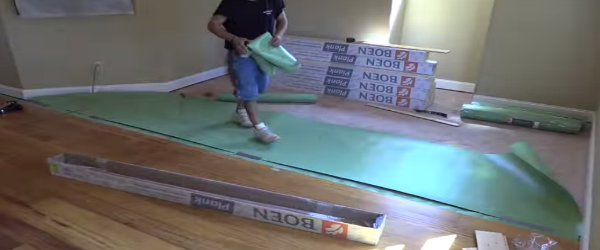Acoustic floor underlayments increases IIC and STC ratings in floors. With the many different acoustic underlayment products, there seems to be some debate on which material works best in floors, as well as the legitimacy of the ratings for these products. We can help resolve some of this confusion…
BOGUS SOUND RATINGS
Some distributors and manufacturers will promote unusually high STC and IIC ratings for floor underlayment products. We believe these ratings perpetuate largely from a lack of understanding for what the ratings represent. Isolation products for walls will occasionally have ratings that are misleading, but rarely to a point of ridiculousness. Marketing for floor underlayment products, however, will claim ratings that are several times better than what is even physically possible in a structure. A few minutes of searching online will result in at least ten random underlayment materials with STC/IIC ratings north of 70. To add to that, most of these 70 plus STC/IIC rated products are only 1/16” thick, or at most 1/4” thick.

To understand how misleading these claims are, we have tests for 2” of solid rubber over 6” of concrete and 4″ of concrete poured over the rubber performing at IIC 64 and STC 72. Now the STC rating could get above 70, but only with 10” of concrete and 2” of rubber. Reduce the thickness of the rubber to 1” and the rating drops to STC 69. Reduce the thickness again to 3/8” and the rating drops to STC 54. From this, it is obvious to anyone with a little sense that if 2” is STC 72, 1” is STC 69, 3/8” is STC 54, then there is no way 1/16” of any material is anywhere near STC 70 plus.
CHARACTERISTICS OF A QUALITY UNDERLAYMENT
Starting first with the characteristics of an underlayment suited for isolating impact footfall noise. Resilience is key to isolating impact footfall noise as it allows a cushion for the energy of sound (pressure of a footstep). Proper resilience can be created within a remarkably thin profile assuming that layer is truly resilient. Meaning it can properly deflect (compress) when put under stress and return to the original form when not under stress. A proper underlayment does not need to be soft like carpet pad, but must be resilient like rubber. Flexible vinyl’s, cork, rolls of composite material, or similar, are not significantly resilient products.
PERFORMANCE OVER DIFFERENT STRUCTURES
The performance of any underlayment will vary considerably depending on the sub-floor, either concrete or wood, and the ceiling below, either resilient or rigid. Because of this, a product claiming a universal rating for IIC or STC will most likely be extremely inaccurate.

CONCRETE SUB-FLOOR
A concrete sub-floor is rigid surface that will not flex. The addition of a thin, resilient material like rubber brings significant gains in isolating footfall noise. These gains increase significantly with a resilient ceiling using either resilient clips or resilient channel.
WOOD SUB-FLOOR
A wood sub-floor is a fairly resilient surface that will flex. Where a thin, resilient rubber over concrete can accomplish quite a bit, the same material over wood will not do nearly as much to increase isolation. If the ceiling below is not resilient, then we suggest a thicker underlayment, like our QT 4010 or thicker, for significant gains in isolation. If the ceiling below is resilient, then a thinner underlayment, like the Iso-Sep PM, can be used to achieve significant gains. There is a point when the structure reaches what is essentially a maximum resilience. Because of this, using thick underlayment, like the QT 4010 or thicker, in a wood structure with resilient ceilings will have minimal value over the thinner Iso-Sep PM products.
For more info on all the floor underlayment products we carry, visit our website at www.hushcitysp.com
Share Blog:
Sharing is caring! Courtesy of Iso Store

